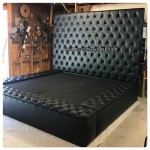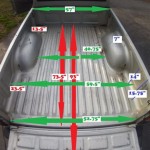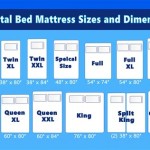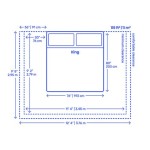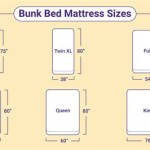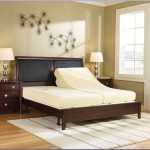What Size Bed Is 60 Inches Wide?
The dimensions of a bed are crucial for comfort, space management, and overall sleep quality. Understanding the standardized sizes available allows consumers to make informed decisions that suit their individual needs and room specifications. In the realm of bed sizes, determining which designation corresponds to a width of 60 inches is fundamental. This article will comprehensively explore the bed size that measures 60 inches wide, its common uses, spatial considerations, and related nuances. The primary focus will be on identifying the bed size with this specific width, providing context for its applications and potential drawbacks.
Many factors contribute to the selection of an appropriate bed size. These include the number of sleepers, the sleeping habits of the occupant(s), the size of the bedroom, and budget constraints. A bed that is too small can lead to discomfort and disturbed sleep, while one that is too large can overwhelm a room and hinder movement. Therefore, careful consideration of available space and personal needs is paramount when choosing a bed. The subsequent sections will delve into the specifics of the 60-inch wide bed and its place among the standard bed sizes available in the market.
The Queen Size Bed: Defining the 60-Inch Width
The bed size that corresponds to a width of 60 inches is the Queen size bed. This is a standard size in the bedding industry and is widely available across various manufacturers and retailers. A Queen size bed typically measures 60 inches in width and 80 inches in length. This translates to 5 feet wide and 6 feet 8 inches long, providing ample space for single sleepers and comfortable accommodation for couples. The Queen size bed is a popular choice due to its versatility and its ability to fit relatively well in moderately sized bedrooms.
Compared to smaller bed sizes like Twin or Full, the Queen size offers significantly more sleeping space. A Twin size bed is typically 38 inches wide, while a Full size bed measures 54 inches in width. This means a Queen size bed provides an extra 6 inches of width compared to a Full size, which can make a noticeable difference in comfort, especially for individuals who tend to move around in their sleep. The added length compared to a Twin size is also a significant advantage for taller individuals, providing better support and preventing their feet from hanging off the end of the bed.
The Queen size bed is smaller than a King size bed, which typically measures 76 inches wide and 80 inches long. This difference of 16 inches in width allows the King size bed to comfortably accommodate two adults with more personal space. However, the larger size of a King size bed requires a larger bedroom, making the Queen size a more practical option for many homes. The Queen size strikes a balance between providing adequate sleeping space and fitting into moderately sized rooms, making it a very popular choice.
The dimensions of a Queen size bed are not always perfectly uniform across different brands and manufacturers. Slight variations of an inch or two may exist, particularly in the length. It is always advisable to verify the exact dimensions of a specific bed frame or mattress before making a purchase, particularly if space constraints are a concern. These variations, while minor, can impact the fit of bedding accessories like mattresses and bed frames.
Benefits and Considerations of a Queen Size Bed
The Queen size bed offers numerous advantages, contributing to its enduring popularity. One of the primary benefits is its suitability for couples. The 60-inch width provides enough space for two adults to sleep comfortably without feeling overly crowded. This allows for better sleep quality and reduces the likelihood of disturbances caused by a partner's movements. For single sleepers who appreciate extra space to stretch out, the Queen size bed offers ample room to move around and find a comfortable sleeping position.
Another significant benefit is its versatility in accommodating various bedroom sizes. While it is smaller than a King size bed and requires less floor space, it still provides considerably more room than a Full size bed. This makes it an ideal choice for guest rooms, master bedrooms, or apartments where space may be limited. It can comfortably fit in a room that is at least 10 feet by 10 feet, allowing for additional furniture such as nightstands and dressers to be incorporated without overwhelming the space.
The availability of bedding and accessories for Queen size beds is also a significant advantage. Due to its widespread popularity, a wide variety of mattresses, sheets, comforters, and bed frames are readily available in Queen size. This expansive selection provides consumers with numerous options in terms of style, material, and price point. Finding suitable bedding for less common bed sizes can be more challenging and potentially more expensive.
However, there are also certain considerations to keep in mind when choosing a Queen size bed. Couples who prefer a considerable amount of personal space while sleeping may find a Queen size bed slightly cramped. In such cases, a King size bed might be a more suitable option. Furthermore, the weight of a Queen size mattress and bed frame can be significant, making it more difficult to move or transport compared to smaller bed sizes. It is important to consider the practicality of moving the bed, especially if frequent relocation is anticipated.
Another factor to consider is the cost associated with Queen size bedding and mattresses. While they are generally more affordable than King size options, they are typically more expensive than Full or Twin size beds. The price will vary based on the quality of materials, brand reputation, and specific features, but the overall cost should be factored into the decision-making process. Consumers should weigh the benefits of the Queen size against their budget constraints to determine the most appropriate option.
Space Requirements and Room Configuration
Proper space planning is essential when incorporating a Queen size bed into a bedroom. While the 60-inch width and 80-inch length are the primary dimensions to consider, it is also important to account for the bed frame's additional dimensions. A typical bed frame can add several inches to the overall footprint of the bed, both in width and length. This can significantly impact the available space in the room and should be factored into the layout. The inclusion of a headboard or footboard can further increase the bed's overall dimensions.
A general guideline is to allow for at least two feet of walking space around the bed. This ensures easy access and prevents the room from feeling cramped. Ideally, there should be sufficient space on both sides of the bed to accommodate nightstands. The nightstands should be positioned within easy reach of the bed, allowing for convenient placement of lamps, books, and other essential items. The distance between the bed and other furniture, such as dressers or wardrobes, should also be carefully considered to allow for comfortable movement and accessibility.
For smaller bedrooms, maximizing space efficiency is crucial. Mounting shelves on the walls can provide additional storage space without taking up valuable floor area. Alternatively, using a bed frame with built-in drawers can offer convenient storage solutions for clothes, linens, or other items. The strategic placement of mirrors can also create the illusion of a larger space, making the room feel more open and airy. The choice of light fixtures can also contribute to the overall ambiance and perceived size of the room.
In larger bedrooms, the placement of the Queen size bed can be more flexible. The bed can be positioned in the center of the room to create a focal point, or it can be placed against a wall to maximize floor space for other activities. A larger room may also accommodate additional seating areas, such as armchairs or loveseats, to create a more comfortable and inviting space. The overall layout should be carefully considered to create a harmonious and functional environment.
Consideration must also be given to the placement of electrical outlets. Ensuring that there are readily accessible outlets near the bed is essential for powering lamps, charging electronic devices, and operating other appliances. If the existing outlets are not conveniently located, extension cords or power strips can be used, but these should be used with caution to avoid tripping hazards or electrical overload. Consulting with an electrician to install additional outlets may be a worthwhile investment to improve the functionality and safety of the bedroom.

Mattress Sizes Chart And Bed Dimensions Guide Amerisleep

Mattress Sizes And Dimensions Guide Sleep Junkie

Bed Sizes Guide Curtain Of Maine

Mattress Size Chart And Bed Dimensions Guide

Mattress Size Guide Secrets For Every Room Eachnight

The Official Organic Mattress Size Guide 2025 Edition

Which Mattress Size Should I Get Texas Makers

Queen Size Bed Dimensions Compared To Other Sizes Eachnight

Adjustable Bed Sizes
Mattress Size Chart And Bed Dimensions Guide 2024


